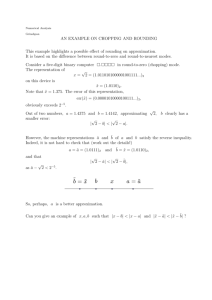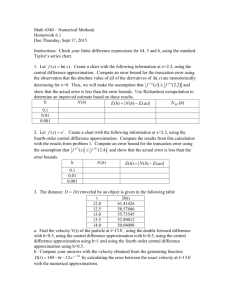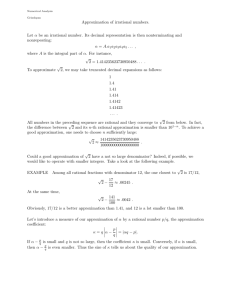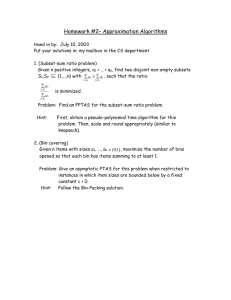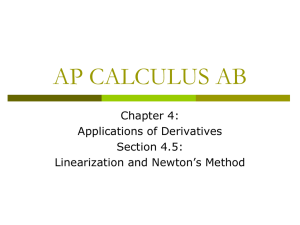4.1 Solutions
advertisement
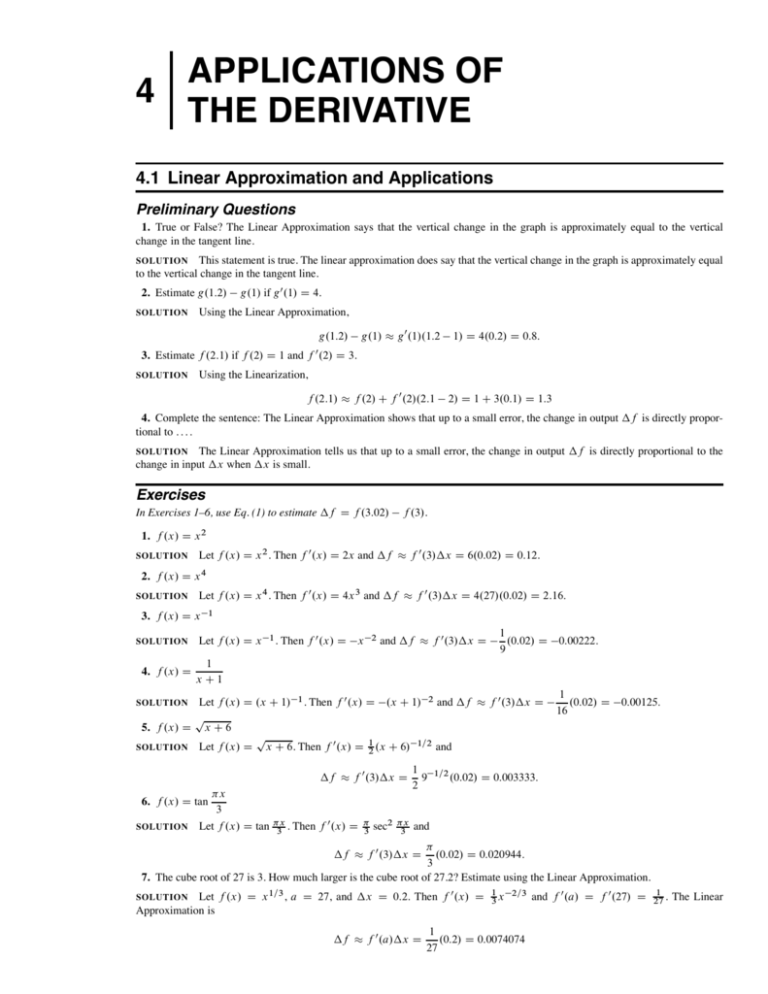
APPLICATIONS OF 4 THE DERIVATIVE 4.1 Linear Approximation and Applications Preliminary Questions 1. True or False? The Linear Approximation says that the vertical change in the graph is approximately equal to the vertical change in the tangent line. SOLUTION This statement is true. The linear approximation does say that the vertical change in the graph is approximately equal to the vertical change in the tangent line. 2. Estimate g.1:2/ ! g.1/ if g 0 .1/ D 4. SOLUTION Using the Linear Approximation, g.1:2/ ! g.1/ " g 0 .1/.1:2 ! 1/ D 4.0:2/ D 0:8: 3. Estimate f .2:1/ if f .2/ D 1 and f 0 .2/ D 3. SOLUTION Using the Linearization, f .2:1/ " f .2/ C f 0 .2/.2:1 ! 2/ D 1 C 3.0:1/ D 1:3 4. Complete the sentence: The Linear Approximation shows that up to a small error, the change in output !f is directly proportional to . . . . SOLUTION The Linear Approximation tells us that up to a small error, the change in output !f is directly proportional to the change in input !x when !x is small. Exercises In Exercises 1–6, use Eq. (1) to estimate !f D f .3:02/ ! f .3/. 1. f .x/ D x 2 SOLUTION Let f .x/ D x 2 . Then f 0 .x/ D 2x and !f " f 0 .3/!x D 6.0:02/ D 0:12. 2. f .x/ D x 4 SOLUTION Let f .x/ D x 4 . Then f 0 .x/ D 4x 3 and !f " f 0 .3/!x D 4.27/.0:02/ D 2:16: 3. f .x/ D x !1 1 Let f .x/ D x !1 . Then f 0 .x/ D !x !2 and !f " f 0 .3/!x D ! .0:02/ D !0:00222: 9 1 4. f .x/ D xC1 1 SOLUTION Let f .x/ D .x C 1/!1 . Then f 0 .x/ D !.x C 1/!2 and !f " f 0 .3/!x D ! .0:02/ D !0:00125: 16 p 5. f .x/ D x C 6 p 1 SOLUTION Let f .x/ D x C 6. Then f 0 .x/ D 2 .x C 6/!1=2 and SOLUTION "x 3 SOLUTION Let f .x/ D tan !f " f 0 .3/!x D 1 !1=2 9 .0:02/ D 0:003333: 2 6. f .x/ D tan !x 3 . Then f 0 .x/ D ! 3 sec2 !x 3 and " .0:02/ D 0:020944: 3 7. The cube root of 27 is 3. How much larger is the cube root of 27.2? Estimate using the Linear Approximation. !f " f 0 .3/!x D Let f .x/ D x 1=3 , a D 27, and !x D 0:2. Then f 0 .x/ D Approximation is SOLUTION !f " f 0 .a/!x D 1 !2=3 3x 1 .0:2/ D 0:0074074 27 and f 0 .a/ D f 0 .27/ D 1 27 . The Linear 356 APPLICATIONS OF THE DERIVATIVE CHAPTER 4 8. Estimate ln.e 3 C 0:1/ ! ln.e 3 / using differentials. SOLUTION Let f .x/ D ln x, a D e 3 , and !x D 0:1. Then f 0 .x/ D x !1 and f 0 .a/ D e !3 . Thus, ln.e 3 C 0:1/ ! ln.e 3 / D !f " f 0 .a/!x D e !3 .0:1/ D 0:00498: In Exercises 9–12, use Eq. (1) to estimate !f . Use a calculator to compute both the error and the percentage error. p 9. f .x/ D 1 C x, a D 3, !x D 0:2 SOLUTION Let f .x/ D !f " f 0 .a/!x D 14 .0:2/ .1 C x/1=2 , a D 3, and !x D 0:2. Then f 0 .x/ D 12 .1 C x/!1=2 , f 0 .a/ D f 0 .3/ D D 0:05. The actual change is p !f D f .a C !x/ ! f .a/ D f .3:2/ ! f .3/ D 4:2 ! 2 " 0:049390: 1 4 and The error in the Linear Approximation is therefore j0:049390 ! 0:05j D 0:000610; in percentage terms, the error is 0:000610 # 100% " 1:24%: 0:049390 10. f .x/ D 2x 2 ! x, a D 5, !x D !0:4 Let f .x/ D 2x 2 ! x, a D 5 and !x D !0:4. Then f 0 .x/ D 4x ! 1, f 0 .a/ D 19 and !f " f 0 .a/!x D 19.!0:4/ D !7:6. The actual change is SOLUTION !f D f .a C !x/ ! f .a/ D f .4:6/ ! f .5/ D 37:72 ! 45 D !7:28: The error in the Linear Approximation is therefore j ! 7:28 ! .!7:6/j D 0:32; in percentage terms, the error is 0:32 # 100% " 4:40%: 7:28 11. f .x/ D SOLUTION f 0 .a/!x D 1 , a D 3, !x D 0:5 1 C x2 Let f .x/ D 1 , 1Cx 2 2x 0 0 a D 3, and !x D :5. Then f 0 .x/ D ! .1Cx 2 /2 , f .a/ D f .3/ D !0:06 and !f " !0:06.0:5/ D !0:03. The actual change is !f D f .a C !x/ ! f .a/ D f .3:5/ ! f .3/ " !0:0245283: The error in the Linear Approximation is therefore j ! 0:0245283 ! .!0:03/j D 0:0054717; in percentage terms, the error is ˇ ˇ ˇ 0:0054717 ˇ ˇ ˇ ˇ !0:0245283 ˇ # 100% " 22:31% 12. f .x/ D ln.x 2 C 1/, a D 1, !x D 0:1 Let f .x/ D C 1/, a D 1, and !x D 0:1. Then f 0 .x/ D 1.0:1/ D 0:1. The actual change is SOLUTION ln.x 2 2x , x 2 C1 f 0 .a/ D f 0 .1/ D 1, and !f " f 0 .a/!x D !f D f .a C !x/ ! f .a/ D f .1:1/ ! f .1/ D 0:099845: The error in the Linear Approximation is therefore j0:099845 ! 0:1j D 0:000155; in percentage terms, the error is 0:000155 # 100% " 0:16%: 0:099845 In Exercises 13–16, estimate !y using differentials [Eq. (3)]. 13. y D cos x, SOLUTION aD ! 6, dx D 0:014 Let f .x/ D cos x. Then f 0 .x/ D ! sin x and !y " dy D f 0 .a/dx D ! sin 14. y D tan2 x, SOLUTION aD ! 4, dx D !0:02 !" " 6 .0:014/ D !0:007: Let f .x/ D tan2 x. Then f 0 .x/ D 2 tan x sec2 x and !y " dy D f 0 .a/dx D 2 tan " " sec2 .!0:02/ D !0:08: 4 4 Linear Approximation and Applications S E C T I O N 4.1 15. y D 10 ! x 2 , a D 1, 2 C x2 SOLUTION Let f .x/ D 357 dx D 0:01 10 ! x 2 . Then 2 C x2 f 0 .x/ D .2 C x 2 /.!2x/ ! .10 ! x 2 /.2x/ 24x D! 2 2 .2 C x / .2 C x 2 /2 and !y " dy D f 0 .a/dx D ! 16. y D x 1=3 e x!1 , a D 1, 24 .0:01/ D !0:026667: 9 dx D 0:1 x 1=3 e x!1 , Let y D a D 1, and dx D 0:1. Then y 0 .x/ D 4 0 !y " dy D y .a/ dx D 3 .0:1/ D 0:133333. SOLUTION 1 !2=3 x!1 e .3x 3x C 1/, y 0 .a/ D y 0 .1/ D In Exercises 17–24, estimate using the Linear Approximation and find the error using a calculator. p p 17. 26 ! 25 p 1 SOLUTION Let f .x/ D x, a D 25, and !x D 1. Then f 0 .x/ D 2 x !1=2 and f 0 .a/ D f 0 .25/ D " " " SOLUTION " and 1 10 . 1 The Linear Approximation is !f " f 0 .a/!x D 10 .1/ D 0:1. The actual change is !f D f .a C !x/ ! f .a/ D f .26/ ! f .25/ " 0:0990195. The error in this estimate is j0:0990195 ! 0:1j D 0:000980486. 18. 16:51=4 ! 161=4 " 4 3, Let f .x/ D x 1=4 , a D 16, and !x D :5. Then f 0 .x/ D 14 x !3=4 and f 0 .a/ D f 0 .16/ D The Linear Approximation is !f " f 0 .a/!x D The actual change is 1 32 .0:5/ 1 32 . D 0:015625. !f D f .a C !x/ ! f .a/ D f .16:5/ ! f .16/ " 2:015445 ! 2 D 0:015445 " The error in this estimate is j0:015625 ! 0:015445j " 0:00018. 19. p 1 101 ! SOLUTION !0:0005. " " 1 10 Let f .x/ D p1 , x 1 D ! 12 x !3=2 and f 0 .a/ D ! 12 . 1000 / D The Linear Approximation is !f " f 0 .a/!x D !0:0005.1/ D !0:0005. The actual change is !f D f .a C !x/ ! f .a/ D p " d .x !1=2 / dx a D 100, and !x D 1. Then f 0 .x/ D 1 101 ! 1 D !0:000496281: 10 The error in this estimate is j!0:0005 ! .!0:000496281/j D 3:71902 # 10!6 . 1 1 20. p ! 98 10 SOLUTION !0:0005. " " " SOLUTION " " p1 , x a D 100, and !x D !2. Then f 0 .x/ D d .x !1=2 / dx 1 D ! 12 x !3=2 and f 0 .a/ D ! 12 . 1000 /D The Linear Approximation is !f " f 0 .a/!x D !0:0005.!2/ D 0:001: The actual change is !f D f .a C !x/ ! f .a/ D f .98/ ! f .100/ D 0:00101525. The error in this estimate is j0:001 ! 0:00101525j " 0:00001525. 21. 91=3 ! 2 " Let f .x/ D Let f .x/ D x 1=3 , a D 8, and !x D 1. Then f 0 .x/ D 13 x !2=3 and f 0 .a/ D f 0 .8/ D 1 The Linear Approximation is !f " f 0 .a/!x D 12 .1/ D 0:083333. The actual change is !f D f .a C !x/ ! f .a/ D f .9/ ! f .8/ D 0:080084. The error in this estimate is j0:080084 ! 0:083333j " 3:25 # 10!3 . 1 12 . 358 CHAPTER 4 22. tan!1 .1:05/ ! SOLUTION " " " APPLICATIONS OF THE DERIVATIVE ! 4 Let f .x/ D tan!1 x, a D 1, and !x D 0:05. Then f 0 .x/ D .1 C x 2 /!1 and f 0 .a/ D f 0 .1/ D 12 . The Linear Approximation is !f " f 0 .a/!x D 12 .0:05/ D 0:025. The actual change is !f D f .a C !x/ ! f .a/ D f .1:05/ ! f .1/ D 0:024385. The error in this estimate is j0:024385 ! 0:025j " 6:15 # 10!4 . 23. e !0:1 ! 1 SOLUTION " " " Let f .x/ D e x , a D 0, and !x D !0:1. Then f 0 .x/ D e x and f 0 .a/ D f 0 .0/ D 1. The Linear Approximation is !f " f 0 .a/!x D 1.!0:1/ D !0:1. The actual change is !f D f .a C !x/ ! f .a/ D f .!0:1/ ! f .0/ D !0:095163. The error in this estimate is j ! 0:095163 ! .!0:1/j " 4:84 # 10!3 . 24. ln.0:97/ SOLUTION " " Let f .x/ D ln x, a D 1, and !x D !0:03. Then f 0 .x/ D 1 x and f 0 .a/ D f 0 .1/ D 1. The Linear Approximation is !f " f 0 .a/!x D .1/.!0:03/ D !0:03, so ln.0:97/ " ln 1 ! 0:03 D !0:03. The actual change is !f D f .a C !x/ ! f .a/ D f .0:97/ ! f .1/ " !0:030459 ! 0 D !0:030459: " The error is j!f ! f 0 .a/!xj " 0:000459. 25. Estimate f .4:03/ for f .x/ as in Figure 1. y y = f (x) (10, 4) Tangent line (4, 2) x FIGURE 1 SOLUTION Using the Linear Approximation, f .4:03/ " f .4/ C f 0 .4/.0:03/. From the figure, we find that f .4/ D 2 and f 0 .4/ D 4!2 1 D : 10 ! 4 3 Thus, 1 f .4:03/ " 2 C .0:03/ D 2:01: 3 26. At a certain moment, an object in linear motion has velocity 100 m/s. Estimate the distance traveled over the next quarter-second, and explain how this is an application of the Linear Approximation. SOLUTION Because the velocity is 100 m/s, we estimate the object will travel # $ ! m" 1 100 s D 25 m s 4 in the next quarter-second. Recall that velocity is the derivative of position, so we have just estimated the change in position, !s, using the product s 0 !t, which is just the Linear Approximation. p p p p 27. Which is larger: 2:1 ! 2 or 9:1 ! 9? Explain using the Linear Approximation. p 1 SOLUTION Let f .x/ D x, and !x D 0:1. Then f 0 .x/ D 2 x !1=2 and the Linear Approximation at x D a gives !f D p a C 0:1 ! p 1 0:05 a " f 0 .a/.0:1/ D a!1=2 .0:1/ D p 2 a We see that !f decreases as a increases. In particular p p 0:05 2:1 ! 2 " p 2 is larger than p p 0:05 9:1 ! 9 " 3 S E C T I O N 4.1 Linear Approximation and Applications 28. Estimate sin 61ı ! sin 60ı using the Linear Approximation. Hint: Express !# in radians. Let f .x/ D sin x, a D Approximation is SOLUTION ! 3, and !x D ! 180 . Then f 0 .x/ D cos x and f 0 .a/ D f 0 . !3 / D 1 2. 359 Finally, the Linear 1! " " " D " 0:008727 2 180 360 29. Box office revenue at a multiplex cinema in Paris is R.p/ D 3600p ! 10p 3 euros per showing when the ticket price is p euros. Calculate R.p/ for p D 9 and use the Linear Approximation to estimate !R if p is raised or lowered by 0:5 euros. !f " f 0 .a/!x D Let R.p/ D 3600p ! 10p 3 . Then R.9/ D 3600.9/ ! 10.9/3 D 25110 euros. Moreover, R0 .p/ D 3600 ! 30p 2 , so by the Linear Approximation, SOLUTION !R " R0 .9/!p D 1170!p: If p is raised by 0.5 euros, then !R " 585 euros; on the other hand, if p is lowered by 0.5 euros, then !R " !585 euros. 30. The stopping distance for an automobile is F .s/ D 1:1s C 0:054s 2 ft, where s is the speed in mph. Use the Linear Approximation to estimate the change in stopping distance per additional mph when s D 35 and when s D 55. SOLUTION " Let F .s/ D 1:1s C 0:054s 2 . The Linear Approximation at s D 35 mph is !F " F 0 .35/!s D .1:1 C 0:108 # 35/!s D 4:88!s ft " The change in stopping distance per additional mph for s D 35 mph is approximately 4:88 ft. The Linear Approximation at s D 55 mph is !F " F 0 .55/!s D .1:1 C 0:108 # 55/!s D 7:04!s ft The change in stopping distance per additional mph for s D 55 mph is approximately 7:04 ft. 31. A thin silver wire has length L D 18 cm when the temperature is T D 30ı C. Estimate !L when T decreases to 25ı C if the coefficient of thermal expansion is k D 1:9 # 10!5ı C!1 (see Example 3). SOLUTION We have dL D kL D .1:9 # 10!5 /.18/ D 3:42 # 10!4 cm=ı C dT The change in temperature is !T D !5ı C, so by the Linear Approximation, the change in length is approximately !L " 3:42 # 10!4 !T D .3:42 # 10!4 /.!5/ D !0:00171 cm At T D 25ı C, the length of the wire is approximately 17:99829 cm. 32. At a certain moment, the temperature in a snake cage satisfies d T =dt D 0:008ı C/s. Estimate the rise in temperature over the next 10 seconds. SOLUTION Using the Linear Approximation, the rise in temperature over the next 10 seconds will be dT !t D 0:008.10/ D 0:08ı C: dt 33. The atmospheric pressure at altitude h (kilometers) for 11 $ h $ 25 is approximately !T " P .h/ D 128e !0:157h kilopascals. (a) Estimate !P at h D 20 when !h D 0:5. (b) Compute the actual change, and compute the percentage error in the Linear Approximation. SOLUTION (a) Let P .h/ D 128e !0:157h . Then P 0 .h/ D !20:096e !0:157h . Using the Linear Approximation, !P " P 0 .h/!h D P 0 .20/.0:5/ D !0:434906 kilopascals: (b) The actual change in pressure is P .20:5/ ! P .20/ D !0:418274 kilopascals: The percentage error in the Linear Approximation is ˇ ˇ ˇ !0:434906 ! .!0:418274/ ˇ ˇ # 100% " 3:98%: ˇ ˇ ˇ !0:418274 360 CHAPTER 4 APPLICATIONS OF THE DERIVATIVE 34. Theˇresistance R of a copper wire at temperature T D 20ı C is R D 15 $. Estimate the resistance at T D 22ı C, assuming that dR=d T ˇT D20 D 0:06 $/ı C. SOLUTION !T D 2ı C. The Linear Approximation gives us: ˇ ˇ R.22/ ! R.20/ " dR=d T ˇˇ !T D 0:06 $=ı C.2ı C/ D 0:12 $: T D20 Therefore, R.22/ " 15 $ C 0:12 $ D 15:12 $. 35. Newton’s Law of Gravitation shows that if a person weighs w pounds on the surface of the earth, then his or her weight at distance x from the center of the earth is W .x/ D wR2 x2 .for x % R/ where R D 3960 miles is the radius of the earth (Figure 2). (a) Show that the weight lost at altitude h miles above the earth’s surface is approximately !W " !.0:0005w/h. Hint: Use the Linear Approximation with dx D h. (b) Estimate the weight lost by a 200-lb football player flying in a jet at an altitude of 7 miles. h 0 396 FIGURE 2 The distance to the center of the earth is 3960 C h miles. SOLUTION (a) Using the Linear Approximation !W " W 0 .R/!x D ! 2wR2 2wh hD! " !0:0005wh: R R3 (b) Substitute w D 200 and h D 7 into the result from part (a) to obtain !W " !0:0005.200/.7/ D !0:7 pounds: 36. Using Exercise 35(a), estimate the altitude at which a 130-lb pilot would weigh 129.5 lb. SOLUTION From Exercise 35(a), the weight loss !W at altitude h (in miles) for a person weighing w at the surface of the earth is approximately !W " !0:0005wh If w D 130 pounds, then !W " !0:065h. Accordingly, the pilot loses approximately 0.065 pounds per mile of altitude gained. The pilot will weigh 129.5 pounds at the altitude h such that !0:065h D !0:5, or h D 0:5=0:065 " 7:7 miles. 37. (a) (b) (c) A stone tossed vertically into the air with initial velocity v cm/s reaches a maximum height of h D v 2 =1960 cm. Estimate !h if v D 700 cm/s and !v D 1 cm/s. Estimate !h if v D 1,000 cm/s and !v D 1 cm/s. In general, does a 1 cm/s increase in v lead to a greater change in h at low or high initial velocities? Explain. SOLUTION A h0 .v/ D v=980. stone tossed vertically with initial velocity v cm=s attains a maximum height of h.v/ D v 2 =1960 cm. Thus, 1 980 .700/.1/ " 0:71 cm. 1 D 980 .1000/.1/ D 1:02 cm. (a) If v D 700 and !v D 1, then !h " h0 .v/!v D (b) If v D 1000 and !v D 1, then !h " h0 .v/!v (c) A one centimeter per second increase in initial velocity v increases the maximum height by approximately v=980 cm. Accordingly, there is a bigger effect at higher velocities. 38. The side s of a square carpet is measured at 6 m. Estimate the maximum error in the area A of the carpet if s is accurate to within 2 centimeters. Linear Approximation and Applications S E C T I O N 4.1 361 Let s be the length in meters of the side of the square carpet. Then A.s/ D s 2 is the area of the carpet. With a D 6 and !s D 0:02 (note that 1 cm equals 0:01 m), an estimate of the size of the error in the area is given by the Linear Approximation: SOLUTION !A " A0 .6/!s D 12 .0:02/ D 0:24 m2 In Exercises 39 and 40, use the following fact derived from Newton’s Laws: An object released at an angle # with initial velocity v ft/s travels a horizontal distance sD 1 2 v sin 2# ft (Figure 3) 32 y x FIGURE 3 Trajectory of an object released at an angle #. 39. A player located 18.1 ft from the basket launches a successful jump shot from a height of 10 ft (level with the rim of the basket), at an angle # D 34ı and initial velocity v D 25 ft/s.) (a) Show that !s " 0:255!# ft for a small change of !#. (b) Is it likely that the shot would have been successful if the angle had been off by 2ı ? 1 SOLUTION Using Newton’s laws and the given initial velocity of v D 25 ft=s, the shot travels s D 32 v 2 sin 2t D where t is in radians. (a) If # D 34ı (i.e., t D 17 90 "), then # $ # $ 625 17 625 17 " !s " s 0 .t/!t D cos " !t D cos " !# & " 0:255!#: 16 45 16 45 180 625 32 sin 2t ft, (b) If !# D 2ı , this gives !s " 0:51 ft, in which case the shot would not have been successful, having been off half a foot. 40. Estimate !s if # D 34ı , v D 25 ft/s, and !v D 2. SOLUTION Using Newton’s laws and the fixed angle of # D 34ı D sD 17 90 ", the shot travels 1 2 17 v sin ": 32 45 With v D 25 ft/s and !v D 2 ft/s, we find 1 17" .25/ sin & 2 D 2:897 ft: 16 45 41. The radius of a spherical ball is measured at r D 25 cm. Estimate the maximum error in the volume and surface area if r is accurate to within 0:5 cm. !s " s 0 .v/!v D SOLUTION The volume and surface area of the sphere are given by V D !r D ˙0:5, then 4 3 3"r and S D 4" r 2 , respectively. If r D 25 and !V " V 0 .25/!r D 4".25/2 .0:5/ " 3927 cm3 ; and !S " S 0 .25/!r D 8".25/.0:5/ " 314:2 cm2 : 42. The dosage D of diphenhydramine for a dog of body mass w kg is D D 4:7w 2=3 mg. Estimate the maximum allowable error in w for a cocker spaniel of mass w D 10 kg if the percentage error in D must be less than 3%. SOLUTION We have D D kw 2=3 where k D 4:7. The Linear Approximation yields !D " 2 !1=3 kw !w; 3 so !D " D 2 !1=3 !w 3 kw kw 2=3 D 2 !w & 3 w If the percentage error in D must be less than 3%, we estimate the maximum allowable error in w to be !w " 3w !D 3.10/ & D .:03/ D 0:45 kg 2 D 2 362 APPLICATIONS OF THE DERIVATIVE CHAPTER 4 43. The volume (in liters) and pressure P (in atmospheres) of a certain gas satisfy P V D 24. A measurement yields V D 4 with a possible error of ˙0:3 L. Compute P and estimate the maximum error in this computation. SOLUTION Given P V P 0 D !24V !2 and D 24 and V D 4, it follows that P D 6 atmospheres. Solving P V D 24 for P yields P D 24V !1 . Thus, !P " P 0 .4/!V D !24.4/!2 .˙0:3/ D ˙0:45 atmospheres: 44. In the notation of Exercise 43, assume that a measurement yields V D 4. Estimate the maximum allowable error in V if P must have an error of less than 0.2 atm. SOLUTION From Exercise 43, with V D 4, we have 3 !P " ! !V 2 or 2 !V D ! !P: 3 If we require j!P j $ 0:2, then we must have j!V j $ 2 .0:2/ D 0:133333 L: 3 In Exercises 45–54, find the linearization at x D a. 45. f .x/ D x 4 , SOLUTION 46. f .x/ D SOLUTION aD1 Let f .x/ D x 4 . Then f 0 .x/ D 4x 3 . The linearization at a D 1 is 1 , x L.x/ D f 0 .a/.x ! a/ C f .a/ D 4.x ! 1/ C 1 D 4x ! 3: aD2 1 x Let f .x/ D D x !1 . Then f 0 .x/ D !x !2 . The linearization at a D 2 is 1 1 1 L.x/ D f 0 .a/.x ! a/ C f .a/ D ! .x ! 2/ C D ! x C 1: 4 2 4 47. f .#/ D sin2 #, SOLUTION 48. g.x/ D SOLUTION aD ! 4 Let f .#/ D sin2 #. Then f 0 .#/ D 2 sin # cos # D sin 2#. The linearization at a D is ! "" 1 " 1 L.#/ D f 0 .a/.# ! a/ C f .a/ D 1 # ! C D#! C : 4 2 4 2 x2 , aD4 x!3 Let g.x/ D ! 4 x2 x!3 . Then g 0 .x/ D .x ! 3/.2x/ ! x 2 x 2 ! 6x D : .x ! 3/2 .x ! 3/2 The linearization at a D 4 is 49. y D .1 C x/!1=2 , a D 0 SOLUTION L.x/ D g 0 .a/.x ! a/ C g.a/ D !8.x ! 4/ C 16 D !8x C 48: Let f .x/ D .1 C x/!1=2 . Then f 0 .x/ D ! 12 .1 C x/!3=2 . The linearization at a D 0 is 1 L.x/ D f 0 .a/.x ! a/ C f .a/ D ! x C 1: 2 50. y D .1 C x/!1=2 , a D 3 Let f .x/ D .1 C x/!1=2 . Then f 0 .x/ D ! 12 .1 C x/!3=2 , f .a/ D 4!1=2 D so the linearization at a D 3 is SOLUTION L.x/ D f 0 .a/.x ! a/ C f .a/ D ! 51. y D .1 C x 2 /!1=2 , SOLUTION 1 2, 1 and f 0 .a/ D ! 12 .4!3=2 / D ! 16 , 1 1 1 11 .x ! 3/ C D ! x C : 16 2 16 16 aD0 Let f .x/ D .1 C x 2 /!1=2 . Then f 0 .x/ D !x.1 C x 2 /!3=2 , f .a/ D 1 and f 0 .a/ D 0, so the linearization at a is L.x/ D f 0 .a/.x ! a/ C f .a/ D 1: S E C T I O N 4.1 Linear Approximation and Applications 363 52. y D tan!1 x, a D 1 SOLUTION Let f .x/ D tan!1 x. Then f 0 .x/ D 1 " 1 ; f .a/ D ; and f 0 .a/ D ; 4 2 1 C x2 so the linearization of f .x/ at a is 53. y D e p SOLUTION L.x/ D f 0 .a/.x ! a/ C f .a/ D x, aD1 Let f .x/ D e p x. 1 " .x ! 1/ C : 2 4 Then 1 p 1 f 0 .x/ D p e x ; f .a/ D e; and f 0 .a/ D e; 2 2 x so the linearization of f .x/ at a is L.x/ D f 0 .a/.x ! a/ C f .a/ D 1 1 e.x ! 1/ C e D e.x C 1/: 2 2 54. y D e x ln x, a D 1 SOLUTION Let f .x/ D e x ln x. Then f 0 .x/ D ex C e x ln x; f .a/ D 0; and f 0 .a/ D e; x so the linearization of f .x/ at a is L.x/ D f 0 .a/.x ! a/ C f .a/ D e.x ! 1/: 55. What is f .2/ if the linearization of f .x/ at a D 2 is L.x/ D 2x C 4? SOLUTION f .2/ D L.2/ D 2.2/ C 4 D 8. 56. Compute the linearization of f .x/ D 3x ! 4 at a D 0 and a D 2. Prove more generally that a linear function coincides with its linearization at x D a for all a. SOLUTION is Let f .x/ D 3x ! 4. Then f 0 .x/ D 3. With a D 0, f .a/ D !4 and f 0 .a/ D 3, so the linearization of f .x/ at a D 0 L.x/ D !4 C 3.x ! 0/ D 3x ! 4 D f .x/: With a D 2, f .a/ D 2 and f 0 .a/ D 3, so the linearization of f .x/ at a D 2 is L.x/ D 2 C 3.x ! 2/ D 2 C 3x ! 6 D 3x ! 4 D f .x/: More generally, let g.x/ D bx C c be any linear function. The linearization L.x/ of g.x/ at x D a is L.x/ D g 0 .a/.x ! a/ C g.a/ D b.x ! a/ C ba C c D bx C c D g.x/I i.e., L.x/ D g.x/. p p 57. Estimate 16:2 using the linearization L.x/ of f .x/ D x at a D 16. Plot f .x/ and L.x/ on the same set of axes and determine whether the estimate is too large or too small. SOLUTION f .x/ is Let f .x/ D x 1=2 , a D 16, and !x D 0:2. Then f 0 .x/ D L.x/ D f 0 .a/.x ! a/ C f .a/ D 1 !1=2 2x and f 0 .a/ D f 0 .16/ D 1 8. The linearization to 1 1 .x ! 16/ C 4 D x C 2: 8 8 p Thus, we have 16:2 " L.16:2/ D 4:025. Graphs of f .x/ and L.x/ are shown below. Because the graph of L.x/ lies above the graph of f .x/, we expect that the estimate from the Linear Approximation is too large. y 5 4 3 2 1 L(x) 0 5 f (x) 10 15 20 25 x 364 APPLICATIONS OF THE DERIVATIVE CHAPTER 4 p p 58. Estimate 1= 15 using a suitable linearization of f .x/ D 1= x. Plot f .x/ and L.x/ on the same set of axes and determine whether the estimate is too large or too small. Use a calculator to compute the percentage error. SOLUTION The nearest perfect square to 15 is 16. Let f .x/ D p1 x 1 ! 128 . The linearization is and a D 16. Then f 0 .x/ D ! 12 x !3=2 and f 0 .a/ D f 0 .16/ D L.x/ D f 0 .a/.x ! a/ C f .a/ D ! 1 1 .x ! 16/ C : 128 4 Then 1 1 1 33 p " L.15/ D ! .!1/ C D D 0:257813: 128 4 128 15 Graphs of f .x/ and L.x/ are shown below. Because the graph of L.x/ lies below the graph of f .x/, we expect that the estimate from the Linear Approximation is too small. The percentage error in the estimate is ˇ ˇ ˇ p1 ! 0:257813 ˇ ˇ 15 ˇ ˇ ˇ # 100% " 0:15% ˇ ˇ 1 p ˇ ˇ 15 y 0.8 0.6 f (x) 0.4 0.2 L(x) 0 5 10 15 20 25 x In Exercises 59–67, approximate using linearization and use a calculator to compute the percentage error. 1 59. p 17 SOLUTION to f .x/ is 1 Let f .x/ D x !1=2 , a D 16, and !x D 1. Then f 0 .x/ D ! 12 x !3=2 , f 0 .a/ D f 0 .16/ D ! 128 and the linearization L.x/ D f 0 .a/.x ! a/ C f .a/ D ! Thus, we have 60. p1 17 " L.17/ " 0:24219. The percentage error in this estimate is ˇ ˇ ˇ p1 ! 0:24219 ˇ ˇ 17 ˇ ˇ ˇ # 100% " 0:14% ˇ ˇ 1 p ˇ ˇ 17 1 101 SOLUTION to f .x/ is 1 1 1 3 .x ! 16/ C D ! xC : 128 4 128 8 Let f .x/ D x !1 , a D 100 and !x D 1. Then f 0 .x/ D !x !2 , f 0 .a/ D f 0 .100/ D !0:0001 and the linearization L.x/ D f 0 .a/.x ! a/ C f .a/ D !0:0001.x ! 100/ C 0:01 D !0:0001x C 0:02: Thus, we have 1 " L.101/ D !0:0001.101/ C 0:02 D 0:0099: 101 The percentage error in this estimate is ˇ ˇ ˇ 1 ! 0:0099 ˇ ˇ 101 ˇ ˇ ˇ # 100% " 0:01% 1 ˇ ˇ 101 1 61. .10:03/2 SOLUTION to f .x/ is Let f .x/ D x !2 , a D 10 and !x D 0:03. Then f 0 .x/ D !2x !3 , f 0 .a/ D f 0 .10/ D !0:002 and the linearization L.x/ D f 0 .a/.x ! a/ C f .a/ D !0:002.x ! 10/ C 0:01 D !0:002x C 0:03: Linear Approximation and Applications S E C T I O N 4.1 365 Thus, we have 1 " L.10:03/ D !0:002.10:03/ C 0:03 D 0:00994: .10:03/2 The percentage error in this estimate is ˇ ˇ ˇ 1 ˇ ˇ .10:03/2 ! 0:00994 ˇ ˇ ˇ # 100% " 0:0027% ˇ ˇ 1 ˇ ˇ .10:03/2 62. .17/1=4 SOLUTION f .x/ is Let f .x/ D x 1=4 , a D 16, and !x D 1. Then f 0 .x/ D L.x/ D f 0 .a/.x ! a/ C f .a/ D 1 !3=4 , 4x f 0 .a/ D f 0 .16/ D 1 32 and the linearization to 1 48 and the linearization to 1 1 3 .x ! 16/ C 2 D xC : 32 32 2 Thus, we have .17/1=4 " L.17/ D 2:03125. The percentage error in this estimate is ˇ ˇ ˇ .17/1=4 ! 2:03125 ˇ ˇ ˇ ˇ ˇ # 100% " 0:035% ˇ ˇ .17/1=4 63. .64:1/1=3 SOLUTION f .x/ is Let f .x/ D x 1=3 , a D 64, and !x D 0:1. Then f 0 .x/ D L.x/ D f 0 .a/.x ! a/ C f .a/ D 1 !2=3 , 3x f 0 .a/ D f 0 .64/ D 1 1 8 .x ! 64/ C 4 D xC : 48 48 3 Thus, we have .64:1/1=3 " L.64:1/ " 4:002083. The percentage error in this estimate is ˇ ˇ ˇ .64:1/1=3 ! 4:002083 ˇ ˇ ˇ ˇ ˇ # 100% " 0:000019% ˇ ˇ .64:1/1=3 64. .1:2/5=3 SOLUTION is Let f .x/ D .1 C x/5=3 and a D 0. Then f 0 .x/ D 5 3 .1 C x/2=3 , f 0 .a/ D f 0 .0/ D L.x/ D f 0 .a/.x ! a/ C f .a/ D Thus, we have .1:2/5=3 " L.0:2/ D 65. cos!1 .0:52/ SOLUTION and the linearization to f .x/ 5 x C 1: 3 5 3 .0:2/ C 1 D 1:3333. The percentage error in this estimate is ˇ ˇ ˇ .1:2/5=3 ! 1:3333 ˇ ˇ ˇ ˇ ˇ # 100% " 1:61% ˇ ˇ .1:2/5=3 Let f .x/ D cos!1 x and a D 0:5. Then f 0 .x/ D ! p and the linearization to f .x/ is 5 3 1 1 ! x2 ; f 0 .a/ D f 0 .0/ D ! L.x/ D f 0 .a/.x ! a/ C f .a/ D ! p 2 3 ; 3 p 2 3 " .x ! 0:5/ C : 3 3 Thus, we have cos!1 .0:52/ " L.0:02/ D 1:024104. The percentage error in this estimate is ˇ ˇ ˇ cos!1 .0:52/ ! 1:024104 ˇ ˇ ˇ ˇ ˇ # 100% " 0:015%: ˇ ˇ cos!1 .0:52/ 66. ln 1:07 SOLUTION Let f .x/ D ln.1 C x/ and a D 0. Then f 0 .x/ D 1 1Cx , f 0 .a/ D f 0 .0/ D 1 and the linearization to f .x/ is L.x/ D f 0 .a/.x ! a/ C f .a/ D x: Thus, we have ln 1:07 " L.0:07/ D 0:07. The percentage error in this estimate is ˇ ˇ ˇ ln 1:07 ! 0:07 ˇ ˇ ˇ # 100% " 3:46%: ˇ ˇ ln 1:07 366 CHAPTER 4 APPLICATIONS OF THE DERIVATIVE 67. e !0:012 SOLUTION Let f .x/ D e x and a D 0. Then f 0 .x/ D e x , f 0 .a/ D f 0 .0/ D 1 and the linearization to f .x/ is L.x/ D f 0 .a/.x ! a/ C f .a/ D 1.x ! 0/ C 1 D x C 1: Thus, we have e !0:012 " L.!0:012/ D 1 ! 0:012 D 0:988. The percentage error in this estimate is ˇ ˇ ˇ e !0:012 ! 0:988 ˇ ˇ ˇ ˇ ˇ # 100% " 0:0073%: ˇ ˇ e !0:012 68. Compute the linearization L.x/ of f .x/ D x 2 ! x 3=2 at a D 4. Then plot f .x/ ! L.x/ and find an interval I around a D 4 such that jf .x/ ! L.x/j $ 0:1 for x 2 I . SOLUTION Let f .x/ D x 2 ! x 3=2 and a D 4. Then f 0 .x/ D 2x ! 32 x 1=2 , f 0 .4/ D 5 and L.x/ D f .a/ C f 0 .a/.x ! a/ D 8 C 5.x ! 4/ D 5x ! 12: The graph of y D f .x/ ! L.x/ is shown below at the left, and portions of the graphs of y D f .x/ ! L.x/ and y D 0:1 are shown below at the right. From the graph on the right, we see that jf .x/ ! L.x/j < 0:1 roughly for 3:6 < x < 4:4. y 12 10 8 6 4 2 x 2 4 x 6 3.6 3.8 4.0 4.2 4.4 p p 69. Show that the Linear Approximation to f .x/ D x at x D 9 yields the estimate 9 C h ! 3 " 16 h. Set K D 0:01 and show that jf 00 .x/j $ K for x % 9. Then verify numerically that the error E satisfies Eq. (5) for h D 10!n , for 1 $ n $ 4. p 1 1 SOLUTION Let f .x/ D x. Then f .9/ D 3, f 0 .x/ D 2 x !1=2 and f 0 .9/ D 6 . Therefore, by the Linear Approximation, f .9 C h/ ! f .9/ D p 1 h: 6 9Ch!3 " Moreover, f 00 .x/ D ! 14 x !3=2 , so jf 00 .x/j D 14 x !3=2 . Because this is a decreasing function, it follows that for x % 9, K D max jf 00 .x/j $ jf 00 .9/j D 1 < 0:01: 108 From the following table, we see that for h D 10!n , 1 $ n $ 4, E $ 12 Kh2 . p h E D j 9 C h ! 3 ! 16 hj 10!1 10!2 10!3 10!4 4:604 # 10!5 4:627 # 10!7 4:629 # 10!9 4:627 # 10!11 1 2 2 Kh 5:00 # 10!5 5:00 # 10!7 5:00 # 10!9 5:00 # 10!11 % & 70. The Linear Approximation to f .x/ D tan x at x D !4 yields the estimate tan !4 C h ! 1 " 2h. Set K D 6:2 and show, using a plot, that jf 00 .x/j $ K for x 2 Œ !4 ; !4 C 0:1%. Then verify numerically that the error E satisfies Eq. (5) for h D 10!n , for 1 $ n $ 4. SOLUTION Let f .x/ D tan x. Then f . !4 / D 1, f 0 .x/ D sec2 x and f 0 . !4 / D 2. Therefore, by the Linear Approximation, !" " !" " !" " f Ch !f D tan C h ! 1 " 2h: 4 4 4 Moreover, f 00 .x/ D 2 sec2 x tan x. The graph of the second derivative over the interval Œ"=4; "=4 C 0:1% is shown below. From this graph we see that K D max jf 00 .x/j " 6:1 < 6:2. y 6.1 5.7 5.3 4.9 4.5 4.1 x 0.78 0.80 0.82 0.84 0.86 0.88 Linear Approximation and Applications S E C T I O N 4.1 367 Finally, from the following table, we see that for h D 10!n , 1 $ n $ 4, E $ 12 Kh2 . h 10!1 10!2 10!3 10!4 E D j tan. !4 C h/ ! 1 ! 2hj 2:305 # 10!2 2:027 # 10!4 2:003 # 10!6 2:000 # 10!8 1 2 2 Kh 3:10 # 10!2 3:10 # 10!4 3:10 # 10!6 3:10 # 10!8 Further Insights and Challenges 71. Compute dy=dx at the point P D .2; 1/ on the curve y 3 C 3xy D 7 and show that the linearization at P is L.x/ D ! 13 x C 53 . Use L.x/ to estimate the y-coordinate of the point on the curve where x D 2:1. SOLUTION Differentiating both sides of the equation y 3 C 3xy D 7 with respect to x yields 3y 2 dy dy C 3x C 3y D 0; dx dx so dy y D! 2 : dx y Cx Thus, and the linearization at P D .2; 1/ is ˇ dy ˇˇ 1 1 D! 2 D! ; ˇ dx .2;1/ 3 1 C2 1 1 5 L.x/ D 1 ! .x ! 2/ D ! x C : 3 3 3 Finally, when x D 2:1, we estimate that the y-coordinate of the point on the curve is 1 5 y " L.2:1/ D ! .2:1/ C D 0:967: 3 3 72. Apply the method of Exercise 71 to P D .0:5; 1/ on y 5 C y ! 2x D 1 to estimate the y-coordinate of the point on the curve where x D 0:55. SOLUTION Differentiating both sides of the equation y 5 C y ! 2x D 1 with respect to x yields 5y 4 dy dy C ! 2 D 0; dx dx so dy 2 D 4 : dx 5y C 1 Thus, and the linearization at P D .0:5; 1/ is ˇ dy ˇˇ 2 1 D D ; dx ˇ.0:5;1/ 3 5.1/2 C 1 L.x/ D 1 C # $ 1 1 1 5 x! D xC : 3 2 3 6 Finally, when x D 0:55, we estimate that the y-coordinate of the point on the curve is y " L.0:55/ D 5 1 .0:55/ C D 1:017: 3 6 73. Apply the method of Exercise 71 to P D .!1; 2/ on y 4 C 7xy D 2 to estimate the solution of y 4 ! 7:7y D 2 near y D 2. 368 APPLICATIONS OF THE DERIVATIVE CHAPTER 4 SOLUTION Differentiating both sides of the equation y 4 C 7xy D 2 with respect to x yields 4y 3 dy dy C 7x C 7y D 0; dx dx so dy 7y D! 3 : dx 4y C 7x Thus, ˇ dy ˇˇ 7.2/ 14 D! D! ; ˇ 3 dx .!1;2/ 25 4.2/ C 7.!1/ and the linearization at P D .!1; 2/ is L.x/ D 2 ! 14 14 36 .x C 1/ D ! x C : 25 25 25 Finally, the equation y 4 ! 7:7y D 2 corresponds to x D !1:1, so we estimate the solution of this equation near y D 2 is y " L.!1:1/ D ! 14 36 .!1:1/ C D 2:056: 25 25 74. Show that for any real number k, .1 C !x/k " 1 C k!x for small !x. Estimate .1:02/0:7 and .1:02/!0:3 . SOLUTION Let f .x/ D .1 C x/k . Then for small !x, we have f .!x/ " L.!x/ D f 0 .0/.!x ! 0/ C f .0/ D k.1 C 0/k!1 .!x ! 0/ C 1 D 1 C k!x " " Let k D 0:7 and !x D 0:02. Then L.0:02/ D 1 C .0:7/.0:02/ D 1:014. Let k D !0:3 and !x D 0:02. Then L.0:02/ D 1 C .!0:3/.0:02/ D 0:994. 75. Let !f D f .5 C h/ ! f .5/, where f .x/ D x 2 . Verify directly that E D j!f ! f 0 .5/hj satisfies (5) with K D 2. SOLUTION Let f .x/ D x 2 . Then !f D f .5 C h/ ! f .5/ D .5 C h/2 ! 52 D h2 C 10h and E D j!f ! f 0 .5/hj D jh2 C 10h ! 10hj D h2 D 1 1 .2/h2 D Kh2 : 2 2 76. Let !f D f .1 C h/ ! f .1/ where f .x/ D x !1 . Show directly that E D j!f ! f 0 .1/hj is equal to h2 =.1 C h/. Then prove that E $ 2h2 if ! 21 $ h $ 12 . Hint: In this case, 21 $ 1 C h $ 32 . SOLUTION Let f .x/ D x !1 . Then !f D f .1 C h/ ! f .1/ D 1 h !1D! 1Ch 1Ch ˇ ˇ E D j!f ! f 0 .1/hj D ˇˇ! ˇ ˇ h h2 C hˇˇ D : 1Ch 1Ch and If ! 12 $ h $ 12 , then 1 2 $1Ch $ 3 2 and 2 3 $ 1 1Ch $ 2. Thus, E $ 2h2 for ! 21 $ h $ 21 . 4.2 Extreme Values Preliminary Questions 1. What is the definition of a critical point? SOLUTION A critical point is a value of the independent variable x in the domain of a function f at which either f 0 .x/ D 0 or f 0 .x/ does not exist.
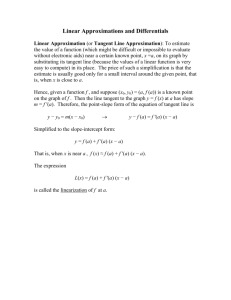
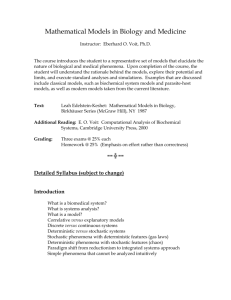
![1 = 0 in the interval [0, 1]](http://s3.studylib.net/store/data/007456042_1-4f61deeb1eb2835844ffc897b5e33f94-300x300.png)
